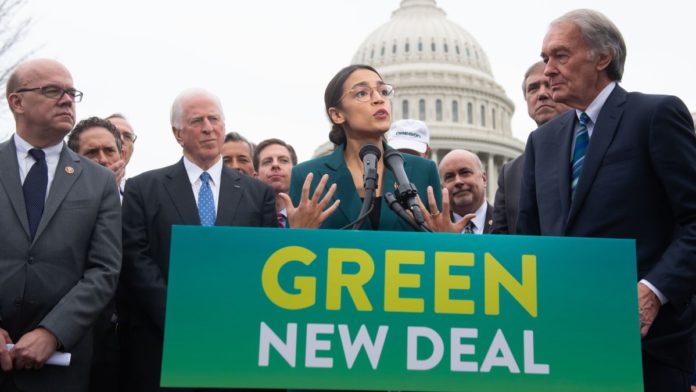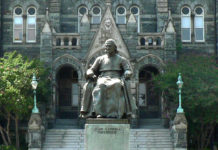![]()
Editor’s Note: I know this article is going to ruffle feathers among our usual readership. However, I would like to draw attention to Mr. Gardner’s quote, “However, the Green New Deal is not universally supported. In fact, many who criticise it often scrutinize the $16.3 trillion proposed spending fee. Beyond this mind-boggling sum of money, questions need to be raised of how funding will be provided for this plan, a topic for a separate article.”
In an ideal world, yes, we would be able to help the environment without nearly doubling the national debt (or, by some reports, many more times than that), but let’s discuss this legislation one step at a time. Regardless, please read Mr. Gardner’s piece with an open mind.
The Green New Deal is not a policy plan known to many Americans. In fact, according to a Gallup Poll published in November 2018, climate change was only the 11th most important issue for the midterm elections, with only 53% of Americans identifying it as extremely/very important.
For a plan that claims to be the revival of President Franklin Delano Roosevelt’s bustling social democracy rise of the 1930s and 40s, it appears that climate change and the Green New Deal has not grabbed many headlines.
That being said, many of the 2020 Democratic candidates are picking up on climate change and introducing Green New Deal-style policies in their political platforms. The most vocal proponent has been Sen. Bernie Sanders (D-VT)—one of the top three contenders for the Democratic nomination—who introduced a Green New Deal resolution with Rep. Alexandria Ocasio-Cortez (D-NY) in February 2019.
At Georgetown University, we hosted many of the Democratic presidential candidates for a discussion on climate change, prompting many in the news media to dedicate more time to covering the climate change debate.
Jay Inslee, a former contender for the Democratic nomination, made climate change his cornerstone policy concern. If the Green New Deal claims to be the revival of FDR’s social democracy, with an emphasis on a green revolution, then what plans and policies are included in it?
For a more comprehensive study of the Green New Deal, it is perhaps essential to analyse the policy proposals of its most enthusiastic supporters, Bernie Sanders, Alexandra Ocasio-Cortez and Sen. Edward Markey (D-MA). Advocates of the Green New Deal aim to reach 100% renewable energy for electricity and transportation by 2030. In addition, there are plans to completely decarbonize the economy by 2050, at the latest.
In order to achieve such an overhaul of the energy sector, the Green New Deal will expand the Federal Power Marketing Administrations to build solar, wind, and geothermal energy sources. In its current state, the Federal Power Marketing Administration only operates electrical systems and hydroelectric dams, selling the electrical output of these federally-owned electric and hydroelectric systems to 33 states. Renewable energy production in the United States under a Green New Deal would vastly increase the scope and operation of the Federal Power Marketing Administration. The Green New Deal does not just tackle climate change itself, but also has economic goals in mind: ending unemployment by creating 20 million jobs.
Hearkening back to the years of FDR, the Green New Deal envisions a reimagined Civilian Conservation Corp (CCC), which was enormously successful. In fact, it was the most popular of all the New Deal programs. In an effort to relieve the economic burdens of Americans, the CCC offered young men the opportunity to do labor work related to the conservation and development of federal lands. As employment was hard to come by in the years after the economic crash, the CCC provided a chance for young men to earn a wage and support their families.
While the aim for reimagining a CCC in the 21st century is to protect and develop federal and rural land, employment is also sought in other areas focused more on combating climate change. This includes employment involved in construction. But there will also be jobs created in other sectors of the economy, such as steel production and auto manufacturing, combined with construction, to build the infrastructure required for a complete overhaul of our current energy system and the transition to a completely decarbonized economy by 2050.
To achieve this goal, renewable power plants and energy efficiency retrofitting will play a big part, since many buildings’ consumption of energy has an extensive impact on global carbon emissions. 82% of energy consumption in buildings came from fossil fuels in 2015, so retrofitting our buildings and homes with energy efficient systems must be included in any discussion about decarbonizing the economy.
For most of the world’s countries (except the United States, which announced it was pulling out in June 2017), the Paris Agreement is a bold project designed to keep global temperatures from rising above 2 degrees Celsius higher than pre-industrial levels. The ideal situation, however, would be to limit the increase to 1.5 degrees to mitigate the risks and impacts of climate change such as on agriculture, rising sea levels, and forest fires, as we have been seeing in Australia.
The Green New Deal, therefore, seeks to retrofit buildings in order to cut back on this fossil fuel energy expenditure and abide by the Paris Agreement. Furthermore, the International Energy Agency (IEA) supports retrofitting buildings. In the Global Status Report of 2017, the IEA highlighted the significance of buildings and construction in global energy consumption and emissions.
However, the Green New Deal is not universally supported. In fact, many who criticise it often scrutinize the $16.3 trillion proposed spending fee. Beyond this mind-boggling sum of money, questions need to be raised of how funding will be provided for this plan, a topic for a separate article. A large part of that sum will be directed towards research and development on how to reduce the cost of energy and how to improve energy storage to reduce inefficiency.
With greater sums of money for research on electric vehicles, we can expect greater efficiency, lower costs related to the charging of electric vehicles, and overall cleaner transportation for millions of Americans. If we cut demand for petroleum by installing electric charging zones, as has been done across America (such as Tesla electric charging stations), we will free ourselves of much of our current pollution problem. According to the EPA, a third of US emissions comes just from the transportation of people and goods, and that’s just petroleum. If the Green New Deal were to successfully cut back on petroleum demand, instead implementing and encouraging individuals to purchase hybrid or electric cars, carbon emissions due to transportation would drastically decrease. Of course, this transition would have to be a gradual process in order to prevent the use of more fossil fuels to run the power plants that provide electricity to the charging stations while research on sustainable energy is being conducted.
A study of carbon emissions would be incomplete without analysing power plants and their role in climate change. Polluting more than transportation, which many believe to be the primary polluter in the United States, electricity production in power plants accounts for 40% of carbon emissions. Of this 40%, 93% of electric industry emissions came from coal burning, exemplifying the massive role fossil fuels still play in energy production to this day. The Green New Deal does not claim to seek a reduction in electricity demand for consumers. Evidently, in the modern, global economy, we cannot do without electricity. Instead, the Green New Deal argues that making massive investments in research into energy storage will help to decrease needless wastage of electricity, when it can be instead stored better. This would undercut our reliance on coal and ensure there is less coal burning.
One of the many pertinent issues in today’s politics is the struggle of the American coal miner. We often hear in the media about the abandonment of the coal miner and the ever-shrinking coal industry. For that reason, many coal families in the Midwest (who are traditionally Democratic voters) switched allegiances in the 2016 election to the candidate who was perceived to be more loyal to coal—Donald Trump. In fact, on a visit to Charleston, West Virginia, in August 2018, many of the attendees waved placards saying, “Trump digs coal,” as the president touted the creation of 2,000 jobs for the coal industry, mostly fuelled by exports. However, analysis by the EPA states that this trend will not continue.
The Green New Deal seeks to support coal miners and provide a just transition for them into the new, global economy of the 21st century. While it would be cruel to dump these miners without a possible replacement for employment, the Green New Deal seeks to administer training for coal miners and transition them to working in the renewable energy sector.
These coal miners will transition to many of the jobs created under the Green New Deal. As previously mentioned, many may work in the CCC to protect our public lands, steel and auto manufacturing, construction, energy efficient retrofitting, and renewable power plants. In an extension to the benefits for coal miners under the Green New Deal, there will be housing assistance in the case of eviction or homelessness, in addition to health care.
Overall, the Green New Deal will also help to take the financial burden off the backs of many Americans. From the workplace to home, the Green New Deal will advocate and implement weatherizing, a process which determines the most cost- and energy-efficient way of heating or cooling internal areas. Typical weatherizing methods are insulation, sealing air leaks, and maximizing door and window efficiency to adapt to weather conditions perfectly. In all, weatherization will lead to better temperature controls throughout summer and winter. With less wastage of heating in internal spaces, energy bills for both firms and families will be reduced, thus saving Americans money.
Transportation will also get a major revamp, with plans focused on making transportation high quality and modern, as well as affordable. In recent years, the U.S. has lagged behind other industrialized nations in providing high-speed trains to its citizens. For instance, no Amtrak train ranks within the top 10 in the world’s fastest trains. In fact, the leading countries in the world with the fastest trains are Italy, Spain, Japan and China. The Green New Deal, therefore, wants to construct higher quality train transportation throughout the country.
The main problem underlying any attempt at solving the global climate problem, however, is the question surrounding who must take on more responsibility to tackle climate change. In any country’s path towards modernization and industrialization, there is inevitably going to be a rise in carbon emissions and other greenhouse gases. The Industrial Revolution in the U.K. led to an exponential increase in the use of coal as an energy source, causing carbon emissions to slowly tick up from 1850 onwards and explode in the post-war era.
After 1945, data indicates that carbon emissions skyrocketed, likely because of the industrialization of the U.S., which had been interrupted due to the Great Depression and the Second World War. In addition, though, China’s and the Soviet Union’s emissions began to increase as those respective countries’ economies also expanded and industrialized. Many countries, obviously, would not like to limit their expansion, industrialization, and development because of the now-pressing problem of climate change. After all, the United States, Great Britain, and the West industrialized and now battle over global hegemony, but no one complained then.
Thus, many developing countries complain that the climate problem has been exacerbated by the West, and now that we face the risk of runaway climate change that affects the entire globe, the West wants to reel everyone back in, while maintaining Western economic standing and global hegemony, maintaining the politics of power nowadays. However, under the Green New Deal, there is an explicit acceptance of the U.S.’s role in the explosion of global emissions, and a promise that efforts will be made so that the U.S. will have an outsized role to play in cutting back on pollution.
The Green New Deal seeks to help in a two-pronged plan set out under America’s obligation. The U.S. should aim to reduce domestic emissions by 71% by 2030, which is double the percentage the Green New Deal expects of less-industrialized nations, at 36%. The message, therefore, of the Green New Deal is that the U.S. has a price to pay if it really wants to solve the climate problem, which not many Americans are willing to reckon with, since it would slow down economic development and the abandonment of traditional industries. The question is whether the United States is prepared to sacrifice some power in order to save the world from climate catastrophe.
Nicolas Gardner (SFS ’23) is a Contributor.
Disclaimer: The views and opinions expressed in this article are those of the author(s) and do not necessarily reflect the official or personal position of the Editorial Board, Contributors, or Business Staff of The Georgetown Review.











